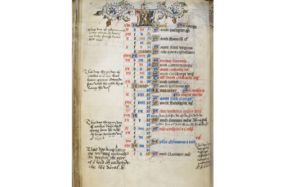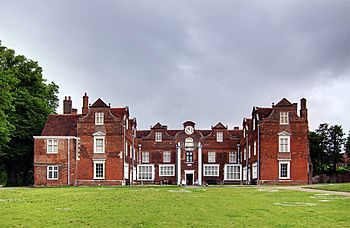Elizabeth Lucar facts for kids
Quick facts for kids
Elizabeth Lucar
|
|
|---|---|
| Born | 1510 |
| Died | October 29, 1537 |
| Occupation | calligrapher |
| Known for | early-modern woman calligrapher |
Elizabeth Lucar (born Withypoll; 1510 – October 29, 1537) was an amazing English woman. She was known for her beautiful handwriting, a skill called calligraphy. She could also speak three languages: Latin, Spanish, and Italian. Besides that, Elizabeth was a talented musician and enjoyed needlework. She was also good at math, which was called "algorism" back then.
Elizabeth came from a rich and important family in London. Her family was well-liked by the King and held important jobs in the city. Her marriage helped bring together two families with similar interests in the Worshipful Company of Merchant Taylors. This was a powerful group of merchants in London.
Contents
Remembering Elizabeth: Her Epitaph
Elizabeth Lucar was born and died in London. Most of what we know about her comes from a special message. This message was carved on her tombstone in St Laurence Pountney church in London. Her husband, Emanuel Lucar, wrote or asked for this message to be made.
The message said: "Elizabeth passed away on October 29, 1537. She was not quite 27 years old. This stone and everything on it was paid for by Emanuel, the Merchant-Taylor."
Sadly, the St. Laurence Pountney church was destroyed in the Great Fire of London in 1666. This huge fire burned down many parts of the city. After the fire, the metal plate with Elizabeth's message was moved. It was placed in another church called St. Michael, Crooked Lane.
Her Amazing Handwriting Skills
In 1904, a writer named D.N. Carvalho mentioned something interesting. He said Elizabeth Lucar wrote an essay about calligraphy in 1525. She was only 15 years old then! He called this essay Curious Calligraphy. He even claimed it was the first English essay ever written on the topic of beautiful handwriting.
However, we don't have this essay today. No one else has ever found or mentioned it. The word "calligraphy" itself wasn't commonly used in England at that time. But we do know Elizabeth was very skilled. Her tombstone message says she could write beautifully in "three manner hands." This means she mastered three different styles of handwriting. She was truly a "curious calligrapher," meaning she was an expert at beautiful writing.
Family and Connections
Elizabeth's father was Paul Withypoll (around 1485–1547). He was a Master Merchant Taylor, a city leader (Alderman), and a Member of Parliament for London. Her mother was Anne, whose father was Robert Curzon.
Elizabeth had a brother named Edmund Withypoll. He also became a Member of Parliament. Their father bought the land where an old church, Holy Trinity Priory, used to be in Ipswich. Edmund then built a large private house there called Christchurch Mansion between 1548 and 1550. Elizabeth was an aunt to Edmund and his wife Elizabeth Hynde's 18 children!
In 1532, Elizabeth received a gift of £50 from her very rich uncle, Robert Thurne. This was a lot of money back then. The Thorne and Withypoll families were involved in international trade. They were also known for collecting valuable and beautiful objects.
Elizabeth married Emanuel Lucar (born 1494, died 1574). He came from Bridgwater in Somerset. Elizabeth and Emanuel had several children: Emanuel, Henry, Mary, Jane, and another daughter. Emanuel later married a second wife, Joan Turnbull, and had more children.
Her Place in History
Elizabeth Lucar's name is honored in a famous art piece called "The Dinner Party" by Judy Chicago. Her name is one of 999 women listed on the "Heritage Floor." This artwork tells the story of women's history in Western civilization. It shows how important women like Elizabeth were throughout time.



